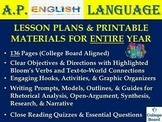38 results
11th grade physics resources for Montessori
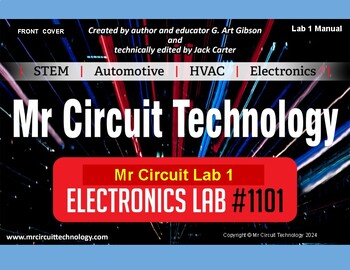
Mr Circuit Lab 1 Basic Electronics Manual with access to online training
Congratulations! You have found the best product for teaching electronics technology to HVAC, AUTOMOTIVE, ROBOTICS, DRONES, and STEM classes. This lab has been the gateway to many people entering the fields of science, physics, electronics and related fields.License: This is an introductory offer to print one copy of the lab manual. There are Price Lists enclosed to order complete labs and the parts necessary to complete all the experiments. Any questions, please call me at 805-295-1642The Mr
Subjects:
Grades:
3rd - 12th, Adult Education
Types:

LAB Chemistry Density of Pennies - with Graphing & Demos
Engage your chemistry students by having them determine the composition of pennies as it changed over time. Students will chart & graph their results. After, you can demonstrate and prove that pennies are made of zinc internally.Included:3 page Student worksheet with procedure, chart, graph & analysis questions1 page teacher density demonstrations (5 easy options)Materials: pennies 13 pre 1982 & 13 post 1982 (per group or 1 set every two groups & switch pennies)graduated cylinder
Subjects:
Grades:
4th - 12th, Higher Education
Types:
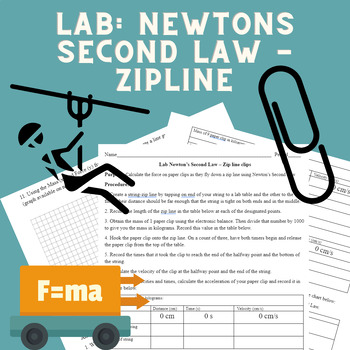
LAB - Integrated Physics/Chem & Physics - Newtons Second Law - Zipline Lab
Objectives: Calculate the force on paper clips as they fly down a zip line using newtons second law.This clear lab allows students to easily graph relationships to connect with visual demonstration. Calculation is clear and proves newtons second law as well as the relationships it expresses.*SUGGESTED TIME TWO DAYS*Materials: tapescalestringpaper clips (20 per group)timerMeter Sticks or Rulers-graphing practice
Subjects:
Grades:
8th - 11th
Types:
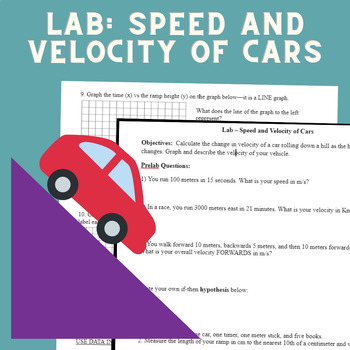
LAB - Integrated Physics/Chem & Physics - Speed & Velocity of Cars Lab
Objectives: Calculate the change in velocity of a car rolling down a hill as the height of a ramp changes. Graph and describe the velocity of your vehicle.This clear lab allows students to easily graph relationships to connect with visual demonstration.Materials: toy cars OR cartsramp (with carts or cardboard)books (or items to stack and raise the height)Meter Sticks or Rulers-graphing practiceThis is an introduction before they learn acceleration, but they get their first look, priming for th
Subjects:
Grades:
8th - 11th
Types:
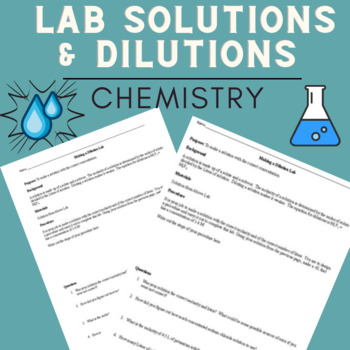
LAB - Chemistry - Make a Solution & Dilution - Easy Materials! - With KEY
This lab has students write their own procedure to make a solution and dilution with teacher observation & testing. This inquiry-STEM activity is great to get students thinking and engaged. Even some of the smartest students fail to connect Molarity to physical performance. This lab allows for that connection.I usually use a pH strip to test their solutions and dilutions! pH probe is better as well.materials:solute - the KEY is with citric acid, but any can be used.BalanceGraduated Cylinderb
Subjects:
Grades:
8th - 11th
Types:
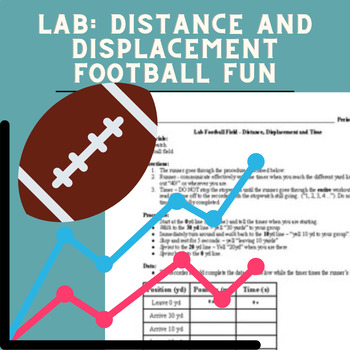
LAB - Integrated Physics/Chem & Physics - Distance & Displacement Football Lab
This key lab allows students to easily identify the difference between distance (position) and displacement. They will also see the direct graph relationship and describe each part of the graph in relation to what was physically happening.This lab really connects the dots for students and is always a favorite.Materials: Stop watch & football field-graphing practiceThis is an introduction before they learn velocity, but they get their first look at the velocity equation here, priming for the
Subjects:
Grades:
8th - 11th
Types:
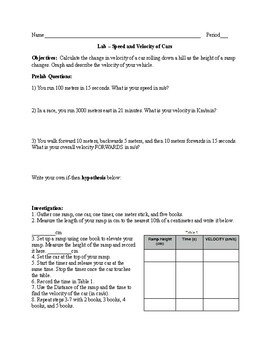
LAB Integrated Chemistry & Physics: Speed & Velocity of Cars - with graphing
Get your students engaged with physics by measuring, graphing and playing with cars! Students will determine the starting point & ending points, taking in data and graphing results.Materials: (per group)one ramp, one car, one timer, one meter stick, and five books.
Subjects:
Grades:
7th - 12th
Types:
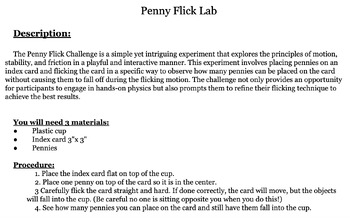
Newtons_First_Law_Lab
Buy Back Your Time! With The Penny Flick Challenge is a simple yet intriguing experiment that explores the principles of motion, stability, and friction in a playful and interactive manner. This experiment involves placing pennies on an index card and flicking the card in a specific way to observe how many pennies can be placed on the card without causing them to fall off during the flicking motion. The challenge not only provides an opportunity for participants to engage in hands-on physics but
Grades:
9th - 12th
Types:
NGSS:
HS-PS2-1

LAB - Integrated Physics/Chem & Physics - Work vs Power Lab
Objectives: Calculate the amount of power you generate climbing stairs. Calculate work vs power. Compare and contrast work vs power.This lab allows students to easily connect mathematical relationships with physical demonstration. This lab is quite easy and fun! It clearly determines what a students work vs power is.Materials: scale OR hand out cards with random newton weights on themmetric ruler/meter stickstairsstopwatch
Subjects:
Grades:
8th - 11th
Types:

LAB Chemistry - Equilibrium Le Chatlier's Principle
Engage your chemistry students by having them performing an equilibrium shift. This lab is empowering because students can SEE the shift right before their eyes. This lab does require quite a bit of set up, but is well worth the effort.Included:1 sheet Lab 2 pagesObjective: Observe and determine the equilibrium shift of the reactionMaterials test tube tongs droppers0.1 M &g Iron (III) Nitrate 0.1 M KSCN 0.1 M NaOH 0.1 M Silver Nitrate 0.5 g KClWater 7 Test Tubes Test Tube Rack Stirring Ro
Subjects:
Grades:
8th - 12th, Higher Education
Types:

LAB Chemistry - Nuclear Decay - Wet Lab
Engage your chemistry students by having them performing an iodine clock reaction -- reimaged to be assigned to nuclear decay! Students will time the clock, graph the results and imagine how the nucleus decays over time.Included:1 sheet Lab 2 pages1 Sheet teacher solution creation directionsObjective: Observe and determine the equilibrium shift of the reactionMaterials Students:• Solution A• Solution B• 2 Erlenmeyer flasks• 3 graduated cylinders • A magnetic stirrer (if available) Timer• Beaker•
Subjects:
Grades:
8th - 12th, Higher Education
Types:
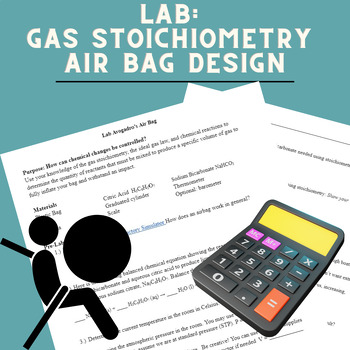
LAB Chemistry Gas Stoichiometry & Gas Laws - Design an Air Bag
Engage your chemistry students by having them observe and perform an inquiry experiment using gas stoichiometry & gas laws to design their own airbag.Be sure to test them by dropping items upon them!MaterialsCitric Acid H3C6H5O7 (grocery)Sodium Bicarbonate NaHCO3 (grocery)Water Graduated cylinderScoopula Plastic Baggies with sealThermometerScale
Subjects:
Grades:
9th - 12th, Higher Education
Types:
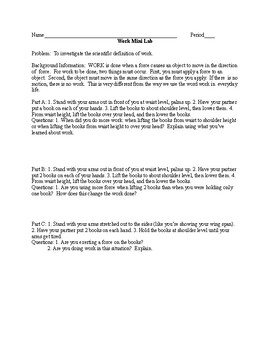
LAB - Integrated Physics/Chem & Physics - Work Mini Lab/Activity
Objectives: Investigate and describe the scientific definition of work.WORK is done when a force causes an object to move in the direction of force. For work to be done, two things must occur. First, you must apply a force to an object. Second, the object must move in the same direction as the force you apply. If there is no motion, there is no work. This is very different from the way we use the word work in everyday life. This lab allows students to easily connect the concept of
Subjects:
Grades:
8th - 11th
Types:
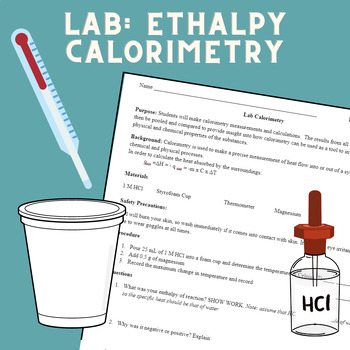
LAB Chemistry Simple Calorimetry (Heat & Enthalpy)
Engage your students by having them observe and perform a small scale calorimetry experiment.Objective: Students will make calorimetry measurements and calculations. The results from all students can then be pooled and compared to provide insight into how calorimetry can be used as a tool to investigate the physical and chemical properties of the substances.Materials1 M HCl Foam CupThermometerZinc OR MagnesiumCalculator
Subjects:
Grades:
9th - 12th, Higher Education
Types:

LAB - Integrated Physics/Chem & Physics - Simplified Friction Lab
Objectives: Calculate each items’ friction coefficient using the average height and base calculated in this laboratory.The force of friction can be calculated by knowing an object’s weight and its friction coefficient. A friction coefficient, µ, tells you how much friction an individual item has.This lab allows students to easily connect mathematical relationships with visual demonstration. Calculation is simplified to display the coefficient, mu, without full trigonometry - only need algebra
Subjects:
Grades:
8th - 11th
Types:
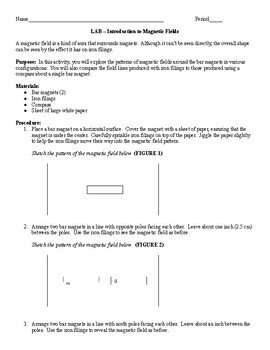
LAB ICP & Physics: Magnetic Fields
Get your students engaged with physics by actually seeing the magnetic field! Students will illustrate the magnetic field based on north & south poles of magnets; multiple magnets. They will also see how a magnet affects a compass. It is quite the experience for them to truly see what scientist before them discovered.This could also be adjusted to use ferro fluids in a petri dish or jar.Materials:Bar magnets (2)Iron filingsCompassSheet of large white paper
Subjects:
Grades:
7th - 12th
Types:
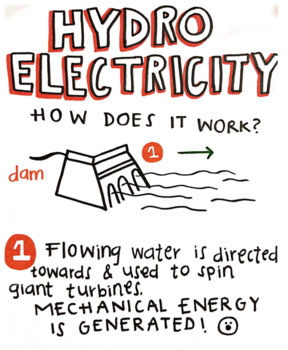
Green/Renewable Energy Hydroelectricity and Wind Turbine Small Posters
Small hand drawn posters that display different aspects of hydroelectric power generation and wind power generation. The connection to both of these types of renewable energy to the electric grid is also presented. This makes a perfect table top display option to talk about hydroelectricity (potential energy conversion) and wind energy (kinetic energy conversion).
Subjects:
Grades:
PreK - 11th
Types:
Also included in: Renewable Energy/Green Energy In Class Exercises or Workshop Tools
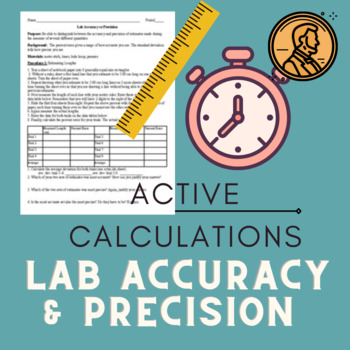
LAB Accuracy and Precision - Kinesthetic, Engaging, and Calculation Practice
Time: 50 minutesMaterials: Rulers, timers/stopwatches/computer for stopwatch, Pennies, & A target (hula hoop, tape on the floor)
Subjects:
Grades:
8th - 11th
Types:
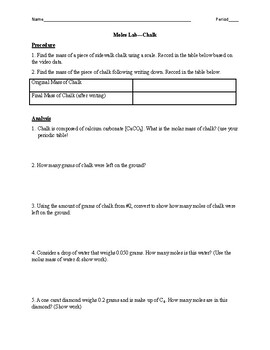
LAB Chemistry - Moles in My Name & Body!
Engage your chemistry students by having them calculate the amount of moles in their name by writing outside with sidewalk chalk, then calculate how many moles are in their own bodies! An easy twist on a classic lab.Included:Lab Worksheet 2 pagesObjective: Calculate the amount of moles in your name & bodyMaterials:scales/balancesSidewalk Chalk (or normal)This activity can be adjusted to play outside or also to write their name onto a piece of paper,
Subjects:
Grades:
8th - 12th, Higher Education
Types:
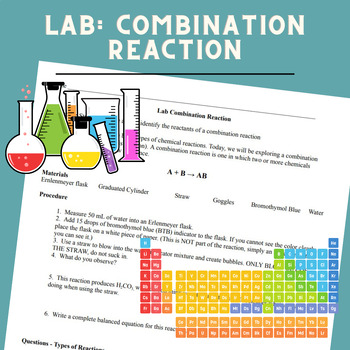
LAB Chemistry - Easy Combination Reaction
Engage your chemistry students by having them perform a quick combination reaction, with a fun color change. This gets students up and moving with easy setup & safety measures. They will write out a full equation for the reaction observed (problem solving) as well as a quick balancing practice.Objective: Observe and predict the reactants of a combination reactionMaterials:Erlenmeyer flaskGraduated CylinderStrawBTB (bromothymol blue) Water
Subjects:
Grades:
7th - 12th, Higher Education
Types:
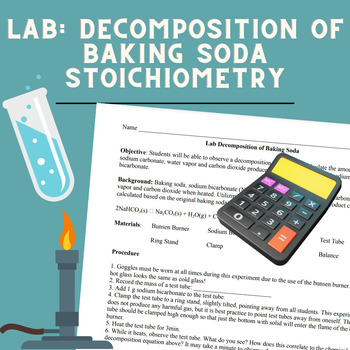
LAB Chemistry - Stoichiometry - Decomposition of Baking Soda with Calculations
Engage your chemistry students by having them perform a decomposition of baking soda by burning it. This will release water (which they will see as condensation), sodium carbonate and CO2. After performing, student will find the percent yield of sodium carbonate and the amount in liters at STP of water vapor and CO2 using stoichiometry.Objective: Students will be able to observe a decomposition reaction and calculate the amount of sodium carbonate, water vapor and carbon dioxide produced from a
Subjects:
Grades:
9th - 12th, Higher Education
Types:
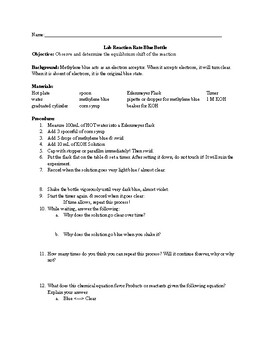
LAB Chemistry - Equilibrium Reaction Rates, Le Chatlier, Equilibrium Constant
Engage your chemistry students by having them performing an equilibrium shift. This lab is empowering because students can SEE the shift right before their eyes. This lab is quick and EASY to set up & the students enjoy the continuous changes. Teacher Note: Every shake adds oxygen back into the reaction!Included:1 sheet Lab 2 pagesObjective: Observe and determine the equilibrium shift of the reactionMaterials Hot plate spoon Erlenmeyer Flask Timerwater methylene blue pipette or drop
Subjects:
Grades:
8th - 12th, Higher Education
Types:
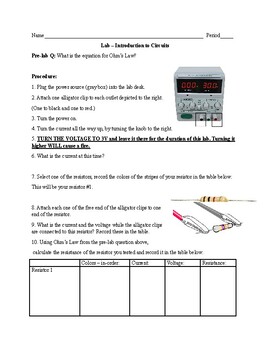
LAB Integrated Chemistry & Physics: Circuits - with graphing & Ohms Law calcs
Get your students engaged with physics by measuring, graphing and building circuits! Students will determine the resistance of various resistors using Ohm's Law.Materials: (per group)Battery soure2 Alligator ClipsResistors*MAKE SURE THE RESISTANCE IS HIGH ENOUGH THAT IT DOES NOT START A FIRE*
Subjects:
Grades:
7th - 12th
Types:
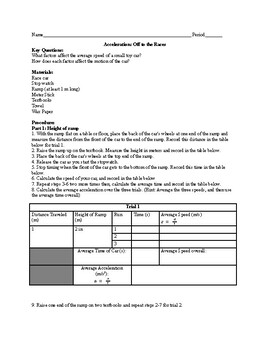
LAB Integrated Chemistry & Physics: Acceleration - with graphing
Get your students engaged with physics by measuring, graphing and playing with cars! Students will determine the starting point & ending points, taking in data and graphing results. They will determine how various materials and heights affect accelerationMaterials:Race carStop watchRamp (at least 1 m long)Meter StickTextbooks TowelWax Paper
Subjects:
Grades:
7th - 12th
Types:
Showing 1-24 of 38 results





